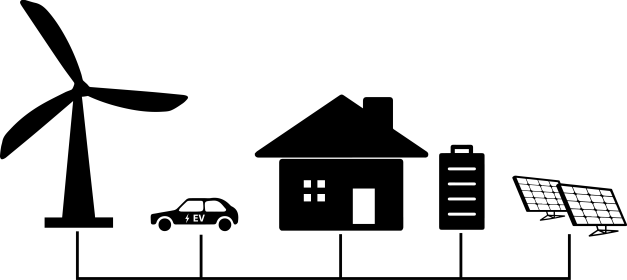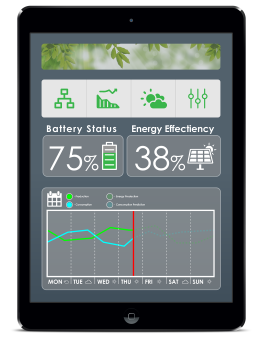Short Description of Project:
The energy sector is evolving very fast, as there is an urgent need to develop renewable sources of electricity. This evolution will put a lot of cost on the final consumer. We at SREC (Smart Renewable Energy Community) want to give the consumers the tools to adapt to these changes and keep their energy bill low. Our system, the Social Smart Grid (SSG) is based on distributed renewable generation, electricity storage and an energy management system (EMS) placed in each houses. With the SSG we will create a community of consumers spread around all denmark that would produce their own electricity, store it in their house and most of all share it in the way that suits the need of the group the best. Within a community, consumers would learn the constraint of stochastic production and to adapt their behavior in order to meet a common goal: cheap electricity through the self reliability of the community. With our idea of a Smart Renewable Energy Community, we change the way consumer view electricity and turn them into an active player of the electric system. Today, electricity is just a utility and its presence is unquestionable. Tomorrow, with renewables, its availability is less easy to achieve. We need the customers to be aware of that.
Problem:
Renewable sources of electricity, although necessary to fight climate change, have characteristics that are less suited to today’s electricity network; they are hard to forecast correctly and very fluctuating. On top of that they don’t necessarily have the same pattern as the consumption. Dealing with these problems for high renewable penetration will be very costly. Denmark already has the one the highest residential electricity price in Europe [1]. There will be a lot of demand for solutions achieve this penetration cheaply.
As it is today, the solutions are mainly looked for in three different directions:
- Expand the grid toward the creation of a Supergrid (European Transmission Network).
- Develop large scale storage solutions, which are still quite costly.
- Focus on distributed generation.
Our solution is based on the two last directions.
Target User:
The main target user will be the danish private household customers from the middle class and the lower middle class. We target our customers regarding their income because the need for our solution will come from the customers for which the electricity bill represents a high share of their income. For instance, households with an income lower than 150 000DKK can have an energy expenditure share of more than 15% [2]. For those between 150 000DKK and 300 000 DKK it is around 10%. In Denmark the targeted customer is evaluated at around 800 000 households [3] which represents a potential market of around 7 billion DKK (the sum of the annual energy bill of our targeted customer)!
Solution
Our solution is based on three level, the hardware, the software and the social aspects:
- Hardware: All houses are considered equipped with electricity storage (possibly Electric vehicles), distributed generation (solar panel or wind turbines), and connected objects to allow for automated demand response but also an integrated power-to-heat solution together with a heat storage, that will allow to use the interconnection between heat and electricity.
 Houses are connected locally into a microgrid using DC connection and the microgrid is connected to the distribution network. The hardware is not a central part of our solution, however, partner companies will be involved to build it.
Houses are connected locally into a microgrid using DC connection and the microgrid is connected to the distribution network. The hardware is not a central part of our solution, however, partner companies will be involved to build it.
- Software: We will create a smart, integrated energy management system, an algorithm that will distribute the energy in a way that is optimizing the usage of resources available. Knowing the constraint of using the grid, the system, will maximize a local use of energy in the house first, then in the microgrid and for the community and finally with the outside world. When exchanging within the grid is used for “transportation” but the whole community appears neutral to the grid (theoritical exchange) Using machine learning, the system will be able to anticipate the behavior of the users and adapt the electric system to it. Again the software part yet necessary, is nothing new, and is not how we are going to differentiate ourselves.
- Social: We want to change the way consumers view energy and how they interact with it. First, the consumer will be able to follow the state of the system through an interactive application.
 The application serves two purposes, one is to inform him on the state of the system, thus educating him on the characteristics of the system, and the other one is that it will allow him in a user-friendly way to interact and control the system making him an active player. Second, a social aspect is added to the application in order to enable interaction between the members of the community. It is our belief that this feeling of being part of a community will be a motivation for the consumers to act as a part of the system turning him into a prosumer.
The application serves two purposes, one is to inform him on the state of the system, thus educating him on the characteristics of the system, and the other one is that it will allow him in a user-friendly way to interact and control the system making him an active player. Second, a social aspect is added to the application in order to enable interaction between the members of the community. It is our belief that this feeling of being part of a community will be a motivation for the consumers to act as a part of the system turning him into a prosumer.
We call our concept Social Smart Grid or Virtual Smart Grid, as it represents a new way to consider energy exchange and self reliability that relies on a non localised community and on social interactions.
How is your concept feasible?
Based on existing commercialized appliance , SSG integrates the following technology together to foster strong self-reliant household or community: energy harnessing, energy storage and conversion, monitor , MAF(monitoring, analysis & forecast) and real-time trade.
Energy harnessing: Solar technology and geothermal heat pump have been proven efficient for individual household.
Energy storage and conversion: In household level, system is facilitated by high energy density supercapacitor and latent heat storage device to balance the actual power and heat consumption. On higher community level, excessive heat and electricity are combined to produce methane and methanol for even longer storage.
In principle, enough renewable energy could be generated to meet most of our energy needs. The technology to convert and store electricity is key to ensure that there is enough power available even when solar panels and wind turbines are not generating electricity.
But the higher the proportion of the energy mix represented by renewable energy sources such as solar and wind power, the greater the fluctuations in electricity generation – varying by the minute, hour, day and season, depending on energy source and region. To offset these fluctuations, the power network needs flexible electricity producers, such as decentralized energy storage systems and power to heat and gas conversion device. These would accumulate electricity when generation exceeds demand, and would release it when renewable sources fail to supply enough.
An overview of technologies:
Power to power
Batteries capable of storing large volumes of electricity have improved greatly in recent years. Siemens has many different approaches ranging from modular battery storage systems like Siestorage (Siemens Energy Storage through to revolutionary systems for energy management like Caterva.
Power to heat
With the transition to a new energy mix, the forecasted heat demand is generated using excess renewable electricity as form of latent heat and later released to household through water heating pipelines. In our system setting large numbers of decentralized household systems could be linked up and coordinated via a communications system to form a “pool” in this case low temperature heat pump could be adopted.
Power to fuel/chemicals
Electricity can be stored more stably for longer period – by generating fuels using chemical gasification synthesis. Danish company Elsam’s approach of Retrol-vision make it possible to produce methanol and ethanol with heat and power production. Besides Chemical synthesis also produce important chemical raw materials in this way. Ammonia, for example, which is used in fertilizer manufacture.
MAF(monitoring, analysis & forecast): The fundamental layout was smart meter and metering network, wide range of sensors and switches and open platform for apps supported by closed APN network and 4G portal communication.
Market-based platform: Price signal updates serves as core trading mechanism to reflect the need for up or down regulation due to an imbalance in the power system which is updated for fixed time intervals. The general concept for a real-time market approach is that it lets distributed energy resources and flexible electricity demand receive and respond to variable electricity prices. The concept provides a market-based platform and ICT infrastructure that extends the current electricity market to a shorter time horizon and to smaller assets.
Four unique value propositions:
- Providing cheap and green distributed energy to the households.
- Turning the consumer into a prosumer/ active player to get him more involved.
- Turning energy into a service and social exchange.
- Bringing stability to the grid by gathering sources of flexibility on demand and with storage.
Business model
Our business model is based on selling services, not energy. The utility (solar panel…) is not where the value is: it is the energy management system that creates the value, as it is the one who allows a significant increase in auto-consumption.
For our solution, we see three main sources of income based on services.
- Reducing the electricity bill. By controlling the cost of production for our community, and reducing the use of the grid, we are able to significantly reduce the electricity bill, saving the consumer some money.
- Providing flexibility sources to the grid: by aggregating the potential for storage and load shedding, the system can offer a significant source of flexibility to cope with large scale renewable generation.
- Collecting consumption data. As the society is diving into a world of big data, the data will be much more valuable should it be of the electric consumption, of the EV usage or of the load shedding potential. As smart meters have not been installed yet, it his hard to evaluate how they will impact, the electric system. Such data will therefore have great value for the grid operator to improve its forecast of the system.
The main revenue is based on a monthly fixed payment that guarantees the consumers a reduction of his bill over time. This fee is paid for the use of the EMS and not the energy. A penalty/reward system is put in place to motivate the customer to act for the community. The pricing for this is based on a simulated internal market. That can be used for the customer as an indicator of the tension on the system.
For the full Business model, see https://canvanizer.com/canvas/uFDeAEl4Ri0
Motivation:
We are very convinced by the potential of our project and we plan to spend some time on a deeper business model analysis to plan the future of our idea.
Link for more information:
[1] https://www.eia.gov/todayinenergy/detail.cfm?id=18851
[2] http://projekter.aau.dk/projekter/files/198484792/Master_Thesis_Energy_Poverty_Sam_Nierop.pdf
[3] https://www.dst.dk/en/Statistik/emner/indkomster
Group Members:
Sebastian Hornbaek, sebastian.hornbak@gmail.com
Etienne Sorin: s151867@student.dtu.dk
Ted Li : teddy2creed@live.com
Elias Illeris Poggi: Elias.illeris@gmail.com

